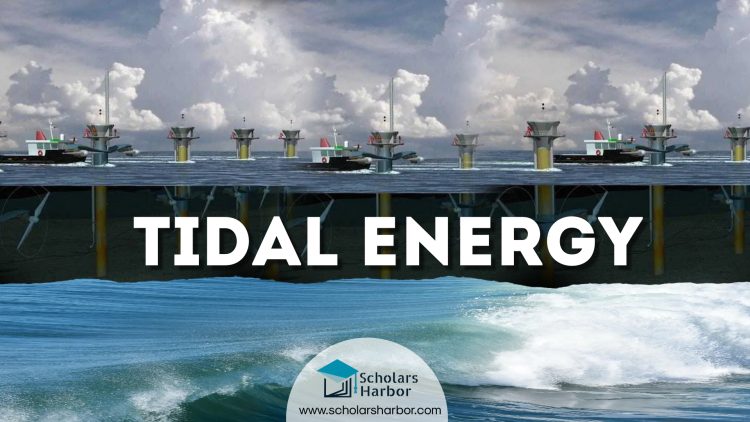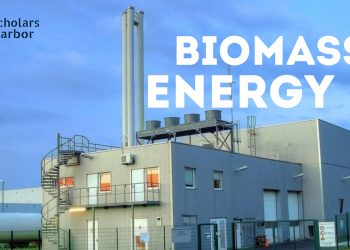Technology advancements in the field of renewable energy are the attractive substitute for traditional sources of energy to ease various problems involving fossil fuels depletion & global warming. The most recent focus has been given to solar energy & wind energy technologies, which has led to significant development in these fields.
The primary drawbacks of the majority of renewable energy systems are their irregular availability & variable energy intensities. Tidal energy is a wide & dependable source of power. Utilizing tidal barrage systems, the development of tidal power is now being explored.
Recent actions to harness this dependable (Tidal) energy source have focused on kinetic energy. This energy extraction process is roughly 15 years later then wind business. However, because it was developed afterward, tidal energy can advantage breakthroughs in technology.
Tidal Energy
The term “tidal energy” refers to the energy produced during tidal motions carried on by the centrifugal & gravitational attraction of the sun, moon, & earth. The continuous rise and fall of the water’s (Ocean) surface caused by the sun’s & moon’s force of gravity & the centrifugal attraction created by their spinning around one another is known as a tide.
Description
In every 24 hours two tidal phenomena take place. A bulge of water results from the moon’s gravitational pull, that is stronger on the earth side closest to moon. Due to spinning of moon and earth, another water bulge develops on the planet’s sides.
The ocean water around a land mass is at peak tide when it aligns & lowest when it is perpendicular from the earth-moon system. As a result, each landmass experiences 2 high tides & 2 low tides for each spinning period of the earth.
Spring tides & neap tides have different sizes of tides. When the moon and earth align with the earth & pull in opposite directions or on the same side, spring tides—which can be very high—occur. Low neap tides result when the moon and earth are located at a right angle.
Tidal Energy Production
Currently, there are two methods for obtaining tidal energy.
- Tidal Barrages
- Tidal Current Turbines
1. Tidal Barrages
This system utilizes tides’ potential energy. A tide barrage is often a dam build in sea or river that experiences tides that are greater than five meter in height. The same concepts as hydropower generating are used to produce power from the tidal stream, with the exception that tides travel in both directions. Both uni & bidirectional turbines are employed in the tidal stream. Single-basin & double-basin are the two categories into which tidal barrages can be divided.
a) Single Basin System
Within a single basin, three different ways of operating are available to produce energy.
-
Ebb Generation
In this system water enters the storage through the sluice gates during this system. The sluice gates close during peak tide, keeping the liquid (water) in the basin. Now, more water may be added during off-peak times, frequently overnight when electricity costs are lowest. Low-head turbines are used to allow the water running out, generate power over many hours.
-
Flood Generation
In this system sluice gates are maintained shut until a considerable hydrostatic level has established across the barrage. Turbine gates are unlocked, enabling water to pass across them towards the basin, once a suitable hydrostatic level has been reached. Due to its negative consequences on transportation and the environment, flood production is a less advantageous means of producing power.
-
Two-way Generation
The flood & ebb stages of the tide are used in this type of process to produce power. Because of the lower maximum output, two-way generating offers the benefit of reducing the amount of time when power is not being produced as well as the expense of turbines.
b) Double-Basin Tidal Barrages
This Systems have 2 basins; primary basin and secondary basin. The flexibility to change the quantity of energy given to consumers to fit their demands distinguish a double basin system from a single basin system.
2. Tidal Current Turbines
Utilizing the kinetic power of flowing water stream tidal current turbines produce power. Technology for tidal currents is comparable to that for wind power. Yet, there are a number of variations in the operating circumstances. In comparable circumstances, water is more than 800 times denser than air and typically travels at a much slower rate.
Tidal encounter more forces and moments than wind. When not producing energy, tidal turbines should be capable of sustaining the stresses and be capable of functioning through both flood and ebb tides. The next 2 are the most often used methods for tidal energy derived.
- Horizontal Axis: The turbines spin on a horizontal axis alongside to the flow of water.
- Vertical Axis: The water flow path is orthogonal to the vertical axis around which the turbines revolve.
Principles of Operation
A tidal current turbine, in its most basic form, comprises of several rotors, which is made up of blades positioned on a hub, a gear as well as a generator. The water is probably flowing effect on the hydrodynamics the rotor rotates as the blades move past it, producing the generator. The rotor is linked to the alternator through a gearbox.
The gearbox is utilized to change the rotor shaft’s rotor velocity into the generator shaft’s required output velocity. Cables are used to transport the generated power to the ground. Following are some examples of tidal current turbines.
- DeltaStream Turbines
- Free Flow Turbines
- Evopod Tidal Turbine
- Gorlov Helical Turbine
- Lunar Energy Tidal Turbine
- Neptune Tidal Stream Device
- Nereus and Solon Tidal Turbines
- Open Centre Turbine
- Pulse Tidal Hydrofoil
- Stingray Tidal Energy Converter
Conclusion
In conclusion, tidal energy is a form of renewable energy that utilizes the power of ocean tides to generate electricity. It is considered to be an environmentally friendly source of energy and has the potential to provide a significant amount of clean and sustainable energy for coastal communities.
While there are challenges that need to be addressed such as high costs and potential impacts on marine life, the potential benefits of this technology make it worth further exploration and investment. With the increasing need for renewable energy and the fight against climate change, tidal energy can play an important role in the transition to a cleaner and more sustainable energy future.
Cite this Article
| Author: | Scholars Harbor |
| Year: | 2022 |
| Title |
Concentrated Solar Power and its Types – Explained |
| Publisher: | Scholars Harbor |
| URL: | https://scholarsharbor.com/what-is-tidal-energy-description-and-its-production/ |










Discussion about this post